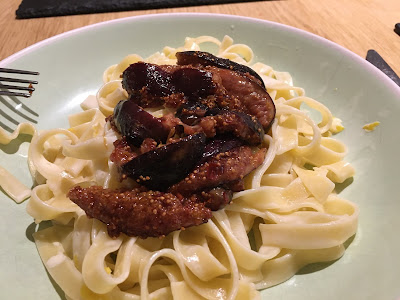I want to be abroad. Specifically, I would like to be
somewhere in Italy, overlooking a vineyard, watching the grapes being
harvested. I am (Covid allowing, obviously…) going to Cornwall in a couple of
weeks, which should be lovely, so I have no right to complain, but I have a
yearning for Italy, at a time when foreign travel still doesn’t seem like a
sensible idea.
I think it’s probably this yearning which has resulted in a
recent enthusiasm for cooking pasta. The other reason for this enthusiasm is
Rachel Roddy’s new book, A-Z of Pasta, which I have mentioned before here.
(Actually on reflection, the book also contributed to my Italian yearnings).
My first pasta was Spaghetti all’amatriciana. I must have
had this at other points, but I fell in love with this one when I had it in
Rome in 2019. (As a side note, I keep wanting to describe 2019 as ‘last year’
when of course it isn’t. Given that 2020 felt like the longest year ever, it’s
odd that it doesn’t seem to have made much impression on my memory). The
secret, I decided, was guanciale. Guanciale is cured pork cheek, and it’s very
hard to get over here. (Pancetta is the usual substitute, but it’s not quite
the same.) However, thanks to Sabrina Ghayour’s Instagram feed I have
discovered a supplier: Cobble Lane Cured. It’s made in London, so avoids Brexit
import issues as well (that said, if seems the British pork industry is about
to collapse, so we’ll see…).
You begin with the guanciale: chop it into small lardons, and place in a dry pan. Fry gently until it renders its’ fat (do not be tempted to add oil, you do not need it!), and starts to turn crispy. At this point, lift the guanciale out and tip the fat into a bowl (you’ll need it again in a second).
 |
| Guanciale (not pancetta!) |
Deglaze the pan with some white wine (or in my case a light rose, as
that was what we were about to drink, having somehow ended up with more rose
than white wine), then add back half the guanciale, three tablespoons of the
fat (if you’re cooking for two – as a side note, three tablespoons was about
all of the fat I had), along with half a tin of tomatoes (you can use chopped
up fresh, but I didn’t have any) and a pinch of chilli flakes. Bring it to the
boil, then simmer for 20 minutes. Cook the pasta, then lift it into the sauce
(so a bit of the pasta water comes along with it), add some grated pecorino,
and toss. Serve, with the retained guanciale and some more pecorino on top. Eat, whilst pretending you’re in Rome.
This week’s other pasta was a bit more unusual: fig, chilli
and lemon tagliatelle from the River Café Easy Cookbook, which is new to me,
even though it’s been out ages. Zest a lemon, and juice half of it. Chop each
fig into 8 pieces. Heat a frying pan, boil the water for the pasta. While the
pasta is cooking, when the pan is very hot, fry the figs until they are
caramelised, then add chilli flakes. Mix the lemon with some double cream, then
mix into the drained pasta, then add the figs. Actually genuinely easy, and
delicious, and unusual. Not as good as actual Italy, but the next best thing.
Pasta with figs - my food photography skills don't seem to have improved over the last 18 months, but this really was delicious.


Well, now I want to be in Italy!
ReplyDeleteThese look really delicious, and I'm always happy to hear new fig recipes especially. I've not been feeling the new cookbooks out lately, but maybe I should get my first River Cafe.
I do feel you about 2020 not feeling like a real year - I too have that problem of squishing it in my mind because so little actually happened. Colleagues who I know aren't "new" turn out to have been with us for 3 years instead of 2 and similar collapsing of timescales.